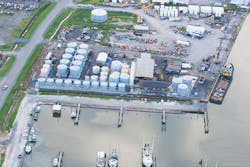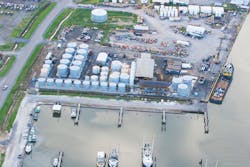Making the most of location to provision offshore operations
Leading-edge completion fluids from Port Fourchon
enable deepwater development in the GoM
Drilling andcompletion can make up as much as 50% of field development costs for deepwater wells. Completion fluids, typically brines made of halides (chlorides and bromides), formates and nitrates, facilitate the final steps that transform a drilled well into a producer. Smoothly making the transition to production – and profitability – relies in great part on using the best completion fluids.
Formulating completion fluids is big business, and it constitutes one of three business divisions of TETRA Technologies, Inc., a geographically diversified oil and gas services company. The TETRA Completion Fluids & Products Division manufactures clear brine fluids, additives, and associated products and provides completion services around the world.
The company focuses on providing specialized solutions that improve quality, safety, and productivity while meeting relevant regulatory requirements. Experienced chemists are at work in a global network of laboratories to develop leading products that include high-density fluids, enhanced brine additives and mud displacement systems.
TETRA has deep roots in Port Fourchon and has expanded its presence six times since the company set up its first facility 35 years ago. (Photo courtesy of TETRA Technologies, Inc.)
Serving the GoM
Headquartered in The Woodlands, Texas, TETRA has four facilities in Louisiana, including one in Port Fourchon that specializes in completion fluid services. According to Barry Barrett, Operations Service Quality Manager, having a facility of this size with a range of capabilities enables the company to provide a breadth of services for drilling and completions contractors and operators in the Gulf of Mexico (GoM).
The 23,226-sq m (250,000-sq ft) facility has 348.4 sq m (3,750 sq ft) warehouse capacity and sits on 259 m (850 ft) of waterfront bulkhead with 6.7 m (22 ft) water depth. There is a 185 cu ft/min air compressor on site as well as a 150-ton crane and two forklifts rated for 4 tons and 18 tons. Material can be loaded simultaneously on two boats using 6-in. load lines flowing at 31.25 b/min and 4-in. load lines flowing at 12.5 b/min.
The onsite clear brine fluid (CBF) plant houses two covered 265-bbl CBF mix pits, three 500-bbl covered mix pits, 62,000 bbl of fixed asset storage capacity and 9,000-bbl CBF staging tanks for pre-blending orders.
TETRA delivers clear brine fluids, chemical additives, lube oils, drill water, potable water and diesel fuel from the Port Fourchon location and provides complete crane services as well as filtration and fluid reclamation services to the GoM. Accommodations on site provide housing for workers, who staff the facility on seven-day shifts.
Having these capabilities in Port Fourchon is important, Barrett said, because it allows the company to provide a broad range of services to its customers in the GoM.
Providing leading solutions
Being able to load vessels and move products around the facility is essential in the bigger picture of servicing the GoM, Barrett said, but the most critical thing is to be able to provide the completion fluids operators need offshore.
There are a lot of factors to consider when formulating completion fluids, said Barrett, and as drilling conditions change, the composition of completion fluids has to keep pace.
“As drilling advanced into deeper water, the conditions encountered – cold temperatures and high pressure – exceeded the parameters of traditional fluids. When completion fluids get colder and pressure is increased, the risk of crystallization increases, which means that solid salts can precipitate, and they can certainly lock up the well,” he explained. “When the industry moved into deeper water, where temperatures are lower and pressures are higher, there was a clear need for new completion fluids that could work under these more demanding conditions.”
Replacement formulations were developed to fill the void. Some used zinc – an element that has since been classified in the US as a marine pollutant and has been banned in the North Sea. Others used cesium formates. These do not present environmental risks, but unfortunately, they are very expensive.
TETRA looked at the industry need and set a goal to develop a completion fluid that was safe for the environment and would not introduce additional health hazards to workers involved in mixing it or handling it. This was an admirable objective, but environmental responsibility was not the only driver. The company also wanted to address supply continuity concerns. Not only is cesium expensive, but availability is constrained. TETRA was determined to develop a completion fluid that used renewable products, could be formulated at a reasonable cost, and required no special mixing, handling, or storage equipment at the rig site.
The result is a family of reusable products that can be formulated as a low-solids, reservoir drill-in fluid as well as a completion fluid.
“Our TETRA CS Neptune fluids deliver a higher density with a low crystallization point,” Barrett said. “The fluids have a neutral pH, so they pose lower health and safety risks to workers in the field, and because they are zinc-free, there is no need for a zero-discharge system. A big plus is that the fluids can be reclaimed using standard technology and recycled in our plants for reuse.”
Barrett is proud of the success of these products, and he is looking forward to the next generation of fluids, which he said will be able to deal with even more exacting environments.
He also is glad to be able to offer the company’s products from the facility in Port Fourchon.
“We are fortunate that we not only have a great product but a fantastic location for serving our clients in the Gulf,” he said.
Working from the port
TETRA has been a tenant in Port Fourchon for 35 years.
“We’ve been on the same dock since day one,” Barrett said. “It’s been an ideal spot for us for years and years.”
At one time, being “ideal” meant workers could hunt ducks during off hours. Today, it means an established presence in a location that allows the company to provide quality service to its GoM clients.
“It’s been a premium spot for us for a long time,” he said. “Off Port Fourchon, the shelf does not extend as far out into the Gulf, which makes it easier to access deepwater from this location,” he explained. “Morgan City used to be a big service location, but vessels had to travel up the Atchafalaya River to get there. Similar transit challenges apply to Venice and Cameron. Our location just makes things easier for us and for our customers.”
TETRA has deep roots in Port Fourchon and has expanded its presence at the port six times since the company first set up shop there.
“If we are not the largest in the world, we certainly are one of the world’s biggest completion fluids plants in terms of capacity,” Barrett said.
While location is a clear advantage, Barrett said, the partnership with the Port Commission is just as important. “They provide protection for all the companies that work here. They communicate with us all the time to keep us informed of hurricanes, flooding, and road closures. And they advocate for improvements to the coastal environment, which is something all of us value.”
The role Port Fourchon plays in helping TETRA and the other tenants provide services for the GoM is important, Barrett said, but the bigger role of the port reaches far beyond the region.
“Port Fourchon is important to the entire United States, not just the state of Louisiana,” he said. •

